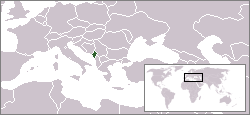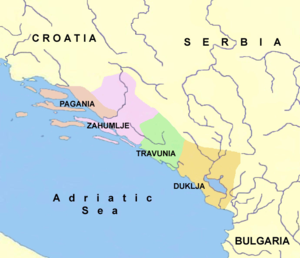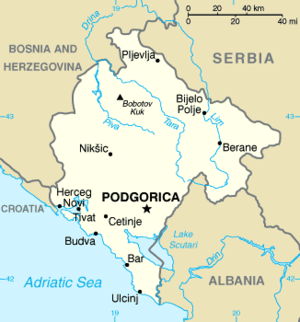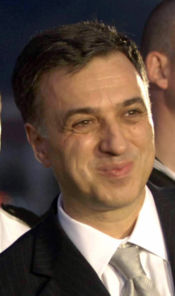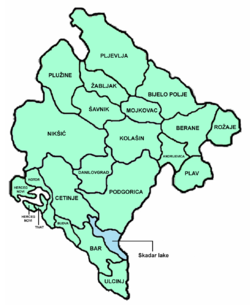Montenegro
2007 Schools Wikipedia Selection. Related subjects: Countries; European Countries
| Република Црна Гора Republika Crna Gora Republic of Montenegro |
|||||
|
|||||
| Anthem: " Oj, svijetla majska zoro" | |||||
| Capital (and largest city) |
Podgorica |
||||
| Official languages | Serbian of the Ijekavian dialect1 | ||||
|---|---|---|---|---|---|
| Government | Republic | ||||
| - President | Filip Vujanović | ||||
| - Prime Minister | Željko Šturanović | ||||
| Independence | From Serbia and Montenegro | ||||
| - Declared | June 3, 2006 | ||||
| - Recognised | June 8, 2006 | ||||
| Area | |||||
| - Total | 14,026 km² ( 159th) 5,414 sq mi |
||||
| - Water (%) | 1.5 | ||||
| Population | |||||
| - 2004 estimate | 630,548 ( 164th) | ||||
| - 2003 census | 620,145 | ||||
| - Density | 44.9/km² ( 152nd) 115.6/sq mi |
||||
| GDP ( PPP) | 2005 estimate | ||||
| - Total | $2.412 billion ( not ranked) | ||||
| - Per capita | $3,800 ( not ranked) | ||||
| HDI (2003) | n/a (n/a) ( n/a) | ||||
| Currency | Euro2 ( EUR) |
||||
| Time zone | CET ( UTC+1) | ||||
| - Summer ( DST) | CEST ( UTC+2) | ||||
| Internet TLD | .yu ( .me)3 | ||||
| Calling code | +381(+382)4 | ||||
| 1 Defined as such in constitution, but subject to some controversy. See Montenegrin language for more details. 2 Adopted unilaterally; Montenegro is not a formal member of the Eurozone. 3 .me will come into use early 2007 while .yu is a holdover from Serbia and Montenegro which is still in use for Montenegrin subdomains . 4 +382 was assigned by the ITU but is not yet activated. Following activation, Serbia's +381 code will remain in use alongside +382 for six months until +382 has been established in Montenegro. |
|||||
Montenegro ( Montenegrin/ Serbian: Црна Гора or Crna Gora, pronounced /'t͡sr̩naː 'ɡɔra/), officially the Republic of Montenegro (Република Црна Гора or Republika Crna Gora), is a country located in southeastern Europe. It has a coast on the Adriatic Sea to the south, and borders Croatia to the west, Bosnia and Herzegovina to the northwest, Serbia to the northeast and Albania to the southeast. Its capital is Podgorica.
Independent from the late Middle Ages until 1918, the country was later a part of various incarnations of Yugoslavia and the state union of Serbia and Montenegro. Based on the results of a referendum held on May 21, 2006, Montenegro declared independence on June 3, 2006. On June 28, Montenegro became the 192nd member state of the United Nations.
Name
Montenegro's native name, Crna Gora, was first mentioned in a charter of St. Nicholas Monastery ( Vranjina) issued by the Serbian King Milutin, in 1296 and translates literally to "black mountain", a reference to the dark forests that once covered the slopes of the Dinaric Alps as seen from the coast. The country's name in most Western European languages, including English, reflects an adoption of the Venetian-language term monte negro, also meaning "black mountain," which probably dates back to the era of Venetian hegemony over the area in the Middle Ages. Other languages, particularly nearby ones, use their own direct translation of the term, e.g. Albanian: Maljitezi, Bulgarian: Черна гора; Romanian: Muntenegru, Greek: Μαυροβούνιο and Turkish: Karadağ; "black mountains" from further afield include Russian: Черногория and Chinese: 黑山 ( pinyin: "hēishān").
The ISO Alpha-2 code for Montenegro is ME and the Alpha-3 Code is MNE.
History
The Slav tribes, mixed with Illyrians, Avars and Romans, formed the semi-independent dukedom of Duklja by the 10th century. In 1077, Pope Gregory VII recognized Duklja as an independent state, acknowledging its King Mihailo (Michael) (of the Vojislavljević dynasty founded by nobleman Stefan Vojislav) as rex Docleae (King of Duklja). The kingdom, however, paid tribute to the Byzantine Empire; later to the Bulgarian Empire; it gave birth to the later medieval kingdom of the Serbian Grand Prince ( Serbian: župan) Stefan Nemanja, who originated from Duklja.
The Principality of Zeta (which more closely corresponds to the early modern state of Montenegro) asserted itself towards 1360. The House of Balšić (1360s–1421) and the House of Crnojević (1421–1499) ruled Zeta; and though the Ottoman Empire controlled the lands to the south and east from the 15th century, it never fully conquered Zeta.
In 1516, the secular prince Đurađ Crnojević abdicated in favour of the Archbishop Vavil, who then made Montenegro into a theocratic state under the rule of the prince-bishop (vladika) of Cetinje, a position held from 1697 by the Petrović-Njegoš family of the Riđani clan. Petar Petrović Njegoš, perhaps the most influential vladika, reigned in the first half of the 19th century. In 1851, Danilo II Petrović Njegoš became vladika, but in 1852 he married, left the priesthood, assumed the title of knjaz (Prince), and transformed his land into a secular principality.
In 1910, Prince Nikola I became King of Montenegro. Two years later, in October, 1912, King Nikola declared war on the Ottoman Empire, precipitating the two Balkan Wars. The Montenegrin army attacked the Ottoman fortress city of Skutari, and forced the empire to gather a large army in neighbouring Macedonia. This Ottoman army was then attacked by the forces of Greece, Serbia, and Bulgaria which entered the war by pre-arrangement. The result was a military disaster for the Ottomans, who were thrown back to an area north of Constantinople.
Montenegro emerged from the Balkan Wars doubled in size, receiving half of the former Ottoman territory known as the Sanjak of Novi Pazar, but without Skutari, the country's major prize in the war. The London Conference awarded Skutari to an independent Albania.
An allied power during World War I, Montenegro was occupied by Austro-Hungarian troops. Feldmarschalleutnant Viktor Weber von Webenau became Military Governor of Montenegro on February 26, 1916. In 1918, the Podgorica Assembly voted for uniting Montenegro with the Kingdom of Serbia. However, pro-independence Montenegrins revolted on Christmas Day 1919 against Serbia. The revolt was finally suppressed in 1924.
From 1919 to 1941, Montenegro was a part of the Kingdom of Serbs, Croats and Slovenes, which renamed itself the Kingdom of Yugoslavia in 1929. During World War II, Montenegro was occupied by Italian troops and later German Axis troops (1941–1944). From 1945 to 1992, Montenegro separated from Serbia and became a constituent republic in its own right of the Socialist Federal Republic of Yugoslavia. It was during this time that the present capital Podgorica was renamed Titograd, after Josip Broz Tito, leader of Yugoslavia. Over the next half century, Montenegro remained one of six constituent republics of Yugoslavia.
Union with Serbia (1992–2006)
After the dissolution of the Socialist Federal Republic of Yugoslavia in 1992, Montenegro agreed on a federation with Serbia, first as the Federal Republic of Yugoslavia, then as a looser State Union of Serbia and Montenegro that broke up as soon as a deadline for holding an independence referendum expired.
In the referendum on remaining in Yugoslavia in 1992, 95.96% of the votes were cast for remaining in the federation with Serbia, although the turnout was at 66% because of a boycott by the Muslim, Albanian and Catholic minorities as well as of pro-independence Montenegrins. The opposition claimed that poll was organized under undemocratic conditions, during war time in the former Yugoslavia, with widespread propaganda from the state-controlled media in favour of a pro-federation vote. There is no impartial report on the fairness of the referendum, as the 1992 referendum was totally unmonitored, unlike the 2006 vote, which was monitored by the European Union.
In 1996, Milo Đukanović's government de facto severed ties between Montenegro and Serbia, which was then still under Milošević. Montenegro formed its own economic policy and adopted the Deutsche Mark as its currency. It has since adopted the euro, though it is not formally part of the Eurozone. Subsequent governments of Montenegro carried out pro-independence policies, and political tensions with Serbia simmered despite political changes in Belgrade. Despite its pro-independence leanings, targets in Montenegro were repeatedly bombed by NATO forces during Operation Allied Force in 1999.
In 2002, Serbia and Montenegro came to a new agreement regarding continued cooperation. In 2003, the Yugoslav federation was replaced in favour of a looser state union named Serbia and Montenegro and a possible referendum on Montenegrin independence was postponed for a minimum of three years.
Independence
The status of the union between Montenegro and Serbia was decided by a referendum on Montenegrin independence on May 21, 2006. A total of 419,240 votes were cast, representing 86.5% of the total electorate. 230,661 votes or 55.5% were for independence and 185,002 votes or 44.5% were against. The 45,659 difference narrowly surpassed the 55% threshold needed to validate the referendum under rules set by the European Union. According to the electoral commission, the 55% threshold was passed by only 2,300 votes. Serbia, the member-states of the European Union, and the permanent members of the United Nations Security Council have all recognized Montenegro's independence; doing so removed all remaining obstacles from Montenegro's path towards becoming the world's newest sovereign state.
The 2006 referendum was monitored by 5 international observer missions, headed by an OSCE/ODIHR monitoring team, and around 3,000 observers in total (including domestic observers from CEMI and other organizations). The OSCE/ODIHR ROM joined efforts with the observers of the OSCE Parliamentary Assembly (OSCE PA), the Parliamentary Assembly of the Council of Europe (PACE), the Congress of Local and Regional Authorities of the Council of Europe (CLRAE) and the European Parliament (EP) to form an International Referendum Observation Mission (IROM). The IROM—in its preliminary report—"assessed compliance of the referendum process with OSCE commitments, Council of Europe commitments, other international standards for democratic electoral processes, and domestic legislation." Furthermore, the report assessed that the competitive pre-referendum environment was marked by an active and generally peaceful campaign and that "there were no reports of restrictions on fundamental civil and political rights."
The 2006 referendum commission, with an equal number of members from both blocs, was headed by a European Union designated official František Lipka (a Slovak diplomat) who held the "golden vote".
On June 3, 2006, the Parliament of Montenegro declared the independence of Montenegro, formally confirming the result of the referendum on independence. Serbia did not obstruct the ruling, confirming its own independence and declaring the Union of Serbia and Montenegro dead shortly thereafter.
International recognition of Montenegro
The first state to recognise Montenegro was Iceland, on June 8, 2006, followed by Switzerland and Estonia on June 9, and Russia on June 11. Recognition by Croatia, Bosnia and Herzegovina and Slovenia soon followed. The European Union and the United States recognized Montenegro on June 12, as have various member states of the EU and other European countries (including Bulgaria). The United Kingdom formally extended recognition on June 13, as did the People's Republic of China and France on June 14, meaning that all five permanent United Nations Security Council members recognise the government of Montenegro. Serbia, the other former component of the State Union, recognised Montenegro on June 15. The Organization for Security and Co-operation in Europe decided to accept Montenegro as the 56th member of the organization on June 21 and the country took its seat at the Permanent Council on June 22. The United Nations, in a vote of the Security Council, decided to offer full membership of the organisation to Montenegro on June 22, 2006. Montenegro was confirmed as a member on June 28.
Geography
Montenegro borders Croatia, Serbia, Bosnia and Herzegovina and Albania.
Some of the cities and towns in Montenegro are:
- Podgorica (capital; 152,025 inhabitants)
- Nikšić (74,706)
- Pljevlja (39,593)
- Bijelo Polje (55,628)
- Herceg Novi (27,593, including Igalo)
- Berane (38,953)
- The former royal capital and the seat of the throne is Cetinje (20,307).
The Montenegrin surface ranges from high peaks along its borders with Kosovo and Albania, a segment of the Karst of the western Balkan Peninsula, to a narrow coastal plain that is only one to four miles wide. The plain stops abruptly in the north, where Mount Lovćen and Mount Orjen plunge abruptly into the inlet of the Bay of Kotor.
Montenegro's large Karst region lies generally at elevations of 1,000 metres (3,281 ft) above sea level — however some parts rise to 2,000 metres (6,560 ft) like Mount Orjen (1,894 m / 6,214 ft), the highest massif among the coastal limestone ranges. Zeta River valley is the lowest segment at an elevation of 500 metres (1,640 ft).
The rough mountains of Montenegro include some of the most rugged terrain in Europe. They average more than 2,000 metres (6,560 ft) in elevation. One of the country's notable peaks is Bobotov Kuk in the Durmitor mountains, which reaches a height of 2,522 metres (8,274 ft). The Montenegrin mountain ranges were among the most ice-eroded parts of the Balkan Peninsula during the last glacial period.
- Longest beach: Velika Plaža, Ulcinj — 13,000 m (8 miles)
- Highest peak: Bobotov Kuk ( Durmitor) — 2,522 m (8,274 ft)
- Largest lake: Lake Skadar — 391 km² (151 sq mi) of surface area
- Deepest canyon: Tara River Canyon — 1,300 m (4,265 ft)
- Biggest bay: Bay of Kotor
- National parks: Durmitor — 390 km² (150 sq mi), Lovćen — 64 km² (25 sq mi), Biogradska Gora — 54 km² (21 sq mi), Lake Skadar — 400 km² (154 sq mi)
- UNESCO World Heritage sites: Durmitor and Tara River Canyon, old city of Kotor.
Government and politics
By its current constitution, Montenegro is defined as a "democratic, welfare, and ecological state".
Government
The current Government of the Republic of Montenegro (Vlada Republike Crne Gore) comprises the prime minister, the deputy prime ministers as well as ministers. Željko Šturanović is the Prime Minister of Montenegro and head of the Government. The ruling party in Montenegro is the centre-left Democratic Party of Socialists of Montenegro (DPS) (Demokratska Partija Socijalista Crna Gore), in coalition with much smaller Social Democratic Party of Montenegro (SDP) (Socijaldemokratska Partija Crne Gore).
President
The President of Montenegro is elected for a period of five years through direct and secret ballots. The President will:
- represent the republic in the country and abroad;
- promulgate laws by ordinance;
- call elections for the Assembly;
- propose to the Assembly candidates for the Prime Minister, president and justices of the Constitutional Court;
- propose to the Assembly calling of a referendum.
- grant amnesty for criminal offences prescribed by the republican law;
- confer decoration and awards;
- perform all other duties in accordance with the Constitution.
The President shall be a member of the Supreme Defence Council.
Parliament
The Montenegrin Parliament (Skupština Republike Crne Gore) passes all laws in Montenegro, ratifies international treaties, appoints the Prime Minister, ministers, and justices of all courts, adopts the budget and performs other duties as established by the Constitution. The Parliament can pass a vote of no-confidence on the Government by a majority of the members. One deputy is elected per 6,000 voters, which in turn results in a reduction of total number of deputies in the Assembly of Montenegro (the present assembly convening comprises 78 deputies instead of previous number of 71). The current president of the Parliament is Ranko Krivokapić.
The present Assembly convening 81 seats instead of previous number of 75 (parliamentary elections were on 10 September 2006 and were the first after the proclamation of independence. The constituent Assembly was on 2 October 2006).
Symbols
A new official flag of Montenegro was adopted on July 12, 2004 by the Montenegrin legislature. The new flag is based on the personal standard of King Nikola I of Montenegro. This flag was all red with a gold border, a gold coat of arms, and the initials НІ in Cyrillic script (corresponding to NI in Latin script) representing King Nikola I. These initials are omitted from the modern flag.
The national day of 13 July marks the date in 1878 when the Congress of Berlin recognised Montenegro as the 27th independent state in the world and the start of one of the first popular uprisings in Europe against the Axis Powers on 13 July 1941 in Montenegro.
In 2004, the Montenegrin legislature selected a popular Montenegrin folk song, " Oh the Bright Dawn of May", as the national anthem. Montenegro's official anthem during the reign of King Nikola was Ubavoj nam Crnoj Gori (To our beautiful Montenegro). The music was composed by the King's son Knjaz Mirko. The Montenegrin popular anthem has been Onamo, 'namo! since King Nikola I wrote it in the 1860s.
Administrative divisions
Montenegro is divided into 21 municipalities ( opština), and 2 urban municipalities, subdivisions of Podgorica municipality:
|
|
Economy
During the era of communism Montenegro experienced a rapid period of urbanization and industrialization. An industrial sector based on electricity generation, steel, aluminium, coal mining, forestry and wood processing, textiles and tobacco manufacture was built up, with trade, overseas shipping, and particularly tourism, increasingly important by the late 1980s.
The loss of previously guaranteed markets and suppliers after the break up of Yugoslavia left the Montenegrin industrial sector reeling as production was suspended and the privatization program, begun in 1989, was interrupted. The disintegration of the Yugoslav market, and the imposition of the UN sanctions in May 1992 were the causes of the greatest economic and financial crisis since World War II. During 1993, two thirds of the Montenegrin population lived below the poverty line, while frequent interruptions in relief supplies caused the health and environmental protection to drop below the minimum of international standards. The financial losses under the adverse effects of the UN sanctions on the overall economy of Montenegro are estimated to be approximately $6.39 billion. This period also experienced the second highest hyperinflation in history (3 million percent in January 1994) (The highest hyperinflation can be attributed to Hungary after the end of World War II where inflation hit 4.19 x 10^16 percent).
Due to its favourable geographical location (it had access to the Adriatic Sea and a water-link to Albania across Lake Skadar) Montenegro became a hub for smuggling activity. The entire Montenegrin industrial production had stopped, and the republic's main economic activity became the smuggling of user goods - especially those in short supply like petrol and cigarettes, both of which skyrocketed in price. It became a de facto legalized practice and it went on for years.
In 1997, Milo Đukanović took control over the ruling Democratic Party of Socialists of Montenegro (DPS) and began severing ties with Serbia. He blamed policies of Slobodan Milošević for overall decline of the Montenegrin economy. Montenegro introduced the German mark as response to again-growing inflation, and insisted on taking more control over its economic fate. This eventually resulted in creation of Serbia and Montenegro, a loose union in which Montenegro mostly took responsibility for its economic policies.
This was followed by implementation of faster and more efficient privatization, passing of reform laws, introduction of VAT and usage of euro as Montenegro's legal tender. The government established a medium-term plan of economic reforms, popularly called "The Agenda".
Demographics
Ethnic composition according to the 2003 census :
- Montenegrins: 267,669 (43.16%)
- Serbs: 198,414 (31.99%)
- Bosniaks: 48,184 (7.77%)
- Albanians: 31,163 (5.03%)
- Muslims by nationality: 24,625 (3.97%)
- Croats: 6,811 (1.1%)
- Roma , Egyptians & Ashkalis: 2,826 (0.46%)
NB: Montenegrin and Serb identities are not exclusive, and the size of each group varies with each census, due to political events and as people view themselves, on balance, as more one than the other. A "Montenegrin" may view himself as a "Serb" as well, and vice versa. In both groups, there are also those who view themselves as belonging to one group exclusively.
Over 270,000 citizens of Serbia have Montenegrin citizenship. Around 69,000 of them are Montenegrins, while others are mostly Serbs. It should be noted that those terms have a slightly different meaning in Serbia. People who may declare themselves Serbs if living in Montenegro, to emphasise their connection with the Serbian cultural space, may declare themselves Montenegrins in Serbia, as the identity needing to be emphasised would be the Montenegrin one.
In the constitution of Montenegro adopted in 1992, the official language of the republic was changed from Serbo-Croat to the Ijekavian standard dialect of Serbian. As of 2003, 63.5% of the population declare Serbian their mother tongue, while almost 22% declare Montenegrin. The dialects used are the same, very similar to those used by Serbs, Croats, and Muslims in Bosnia-Herzegovina and Croatia, with slight nuances.
Over 74% of Montenegrin citizens are Eastern Orthodox Christians, most of them adherents of the Serbian Orthodox Church, although there is also the Montenegrin Orthodox Church, which is not officially recognized. 110,000 Muslims make up 17.74% of Montenegro's population. They are divided into three main groups: ethnic Albanians, and Slavic Muslims split among Bosniaks, who speak Bosnian and Montenegrin Muslims, who prefer Serbian. Albanians are a separate group, speaking their own language, Albanian (5.26%) and living mostly in the south-east, especially in Ulcinj, where they form the majority of the population. Bosniaks are Slavic Muslims speaking the Bosnian language and living mostly in the north. Finally, there are a small groups of autochthonous Croats and other Roman Catholic inhabitants, who live mostly in the coastal areas, particularly the Bay of Kotor. New estimates of Croats in 2006 put the figure at 7,100.
Culture
Because of the country's location, the culture of Montenegro has been shaped by a variety of influences throughout history. The influence of Orthodox South Slavic, Central European, and seafaring Adriatic cultures (notably parts of Italy) have been the most imporant in recent centuries.
Montenegro has many significant cultural and historical sites, including heritage sites from the pre- Romanesque, Gothic and Baroque periods. The Montenegrin coastal region is especially well known for its religious monuments, including the Cathedral of Saint Tryphon, the basilica of St. Luke (over 800 years), Our Lady of the Rock (Škrpjela), the Savina Monastery and others. The Byzantine influence in architecture and in religious artwork is especially apparent in the country's interior. Montenegro's medieval monasteries contain thousands of square metres of frescos on their walls.
The traditional folk dance of the Montenegrins is the Oro, a circle dance that involves dancers standing on each other's shoulders in a circle while one or two dancers are dancing in the middle.
The first literary works written in the region are ten centuries old, and the first Montenegrin book was printed five hundreds years ago. The first state-owned printing press was located in Cetinje in 1494, where the first South Slavic book was printed the same year ( Oktoih). Ancient manuscripts, dating from the 13th century, are kept in the Montenegrin monasteries.
Montenegro's capital Podgorica and the former royal capital of Cetinje are the two most importantant centers of culture and the arts in the country.
Education
Education in Montenegro is regulated by the Montenegrin Ministry of Education and Science.
Education starts in either pre-schools or elementary schools. Children enroll in elementary schools ( Serbian: Osnovna škola) at age of 7 and it lasts for nine years. The students may continue their secondary education which lasts 3 ,or in great majority of cases 4 years and ends with graduation( Matura). Higher education lasts with a certain first degree after 3 to 6 years. Universities also offer postgraduate education.
Gallery
|
Njegoš's mausoleum on top of the Mount Lovćen. |
Ostrog monastery. |
||
Neighbouring countries
 |
 |
|||
Albania · Andorra · Armenia1 · Austria · Azerbaijan2 · Belarus · Belgium · Bosnia and Herzegovina · Bulgaria · Croatia · Cyprus1 · Czech Republic · Denmark · Estonia · Finland · France · Georgia2 · Germany · Greece · Hungary · Iceland · Ireland · Italy · Kazakhstan2 · Latvia · Liechtenstein · Lithuania · Luxembourg · Republic of Macedonia · Malta · Moldova · Monaco · Montenegro · Netherlands · Norway · Poland · Portugal · Romania · Russia2 · San Marino · Serbia · Slovakia · Slovenia · Spain · Sweden · Switzerland · Turkey2 · Ukraine · United Kingdom · Vatican City
(1) Entirely in Asia but having socio-political connections with Europe. (2) Has significant territory in Asia.
Albania • Algeria • Bosnia and Herzegovina • Croatia • Cyprus • Egypt • France • Greece • Israel • Italy • Lebanon • Libya • Malta • Monaco • Montenegro • Morocco • Slovenia • Spain • Syria • Tunisia • Turkey
For dependent and other territories, see Dependent territory and List of unrecognized countries.
![]() Albania •
Albania • ![]() Bosnia and Herzegovina •
Bosnia and Herzegovina • ![]() Croatia •
Croatia • ![]() Italy •
Italy • ![]() Montenegro •
Montenegro • ![]() Slovenia
Slovenia
Austria • Belgium • Cyprus • Czech Republic • Denmark • Estonia • Finland • France • Germany • Greece • Hungary • Ireland • Italy • Latvia • Lithuania • Luxembourg • Malta • Netherlands • Poland • Portugal • Slovakia • Slovenia • Spain • Sweden • United Kingdom
Countries acceding on January 1, 2007: Bulgaria • Romania
Candidate countries: Croatia • Turkey • Republic of Macedonia (referred to as the former Yugoslav Republic of Macedonia by the European Union)
West Slavic: ![]() Czech Republic •
Czech Republic • ![]() Poland •
Poland • ![]() Slovakia
Slovakia
South Slavic: ![]() Bosnia and Herzegovina •
Bosnia and Herzegovina • ![]() Bulgaria •
Bulgaria • ![]() Croatia •
Croatia • ![]() Republic of Macedonia •
Republic of Macedonia • ![]() Montenegro •
Montenegro • ![]() Serbia •
Serbia • ![]() Slovenia
Slovenia
|
Bosnia and Herzegovina • Croatia • Republic of Macedonia • Montenegro • Serbia (Kosovo • Vojvodina) • Slovenia |


